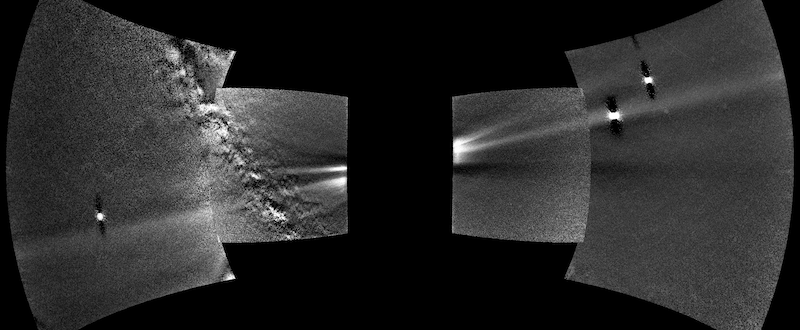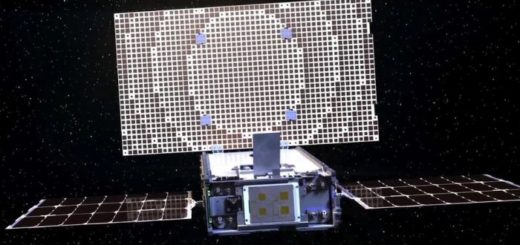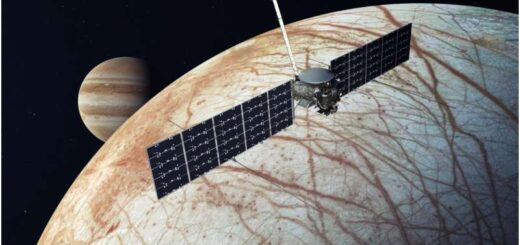1st Complete View Of Venus’ Orbital Dust Ring

This isn’t some sort of flare – or glare – or any kind of jet or ray. It’s the first complete view of a ring of dust moving around the sun in the orbit of the planet Venus. The 4 frames of the image were first captured on August 25, 2019. Image via NASA/ Johns Hopkins APL/ Naval Research Laboratory/ Guillermo Stenborg and Brendan Gallagher.
Did you know that Venus has a ring? Well, sort of. Not a ring of icy or dusty “moonlets” or grains like those surrounding the gas and ice giants in our solar system, Jupiter, Saturn, Uranus and Neptune. Instead, it’s a circumsolar ring of dust, that is, a ring of dust moving around the sun along Venus’ orbit. Now, NASA’s Parker Solar Probe has sent back the first complete view of this ring, the space agency reported on April 16, 2021.
Previous spacecraft had provided partial views of the ring, but this is the first time it has been imaged for nearly the full 360 degrees around the sun.
Researchers published the peer-reviewed results in The Astrophysical Journal on April 7, 2021.
Lead author Guillermo Stenborg from the U.S. Naval Research Laboratory said that:
This is the first time that a circumsolar dust ring in the inner solar system could be revealed in its full glory in ‘white light’ images. I find that pretty special.
Venus is embedded within the ring, which circles the sun much as the asteroid belt does. But this ring is only composed of very fine, microscopic dust particles. The ring isn’t that easy to see, so how did Parker Solar Probe image it?
The probe used its Wide-field Imager for Solar Probe (WISPR) instrument, which is primarily for observing the solar wind, a stream of charged particles from the sun. The solar wind is fainter than the dust in interplanetary space. The dust is easier to see in images since it reflects about 100 times more light than the particles in the solar wind. That same kind of dust creates the zodiacal light, which can be seen on Earth as a faint column of light projecting upwards from the horizon.
To observe the solar wind, the mission team processed the images to remove the space dust. What they didn’t realize at first was that the Venus dust ring was also removed from the images during this process. It was seen later, however, after Parker Solar Probe changed the orientation of its cameras during rolling maneuvers (to prepare for its next flyby of the sun). Parker Solar Probe Project Scientist Nour Raouafi said:
It’s funny that spacecraft operations can sometimes lead to the discovery of new things. It’s kind of amazing.
Analysis of the images suggests that the dust in the ring is about 10 times more dense than dust in the surrounding interplanetary space.
Spacecraft with large, active, orange and yellow sun in the background.
Artist’s concept of Parker Solar Probe as it nears the sun during one of its orbits. The spacecraft is about the size of a small car. It’s designed to travel directly through the sun’s atmosphere, ultimately to within about 4 million miles of the sun’s surface. Image via NASA/ Johns Hopkins APL/ Steve Gribben.
Two earlier missions that observed the Venus dust ring are the German-American Helios spacecraft and NASA’s STEREO mission. Scientists have been able to develop new models of the dust ring based on those measurements. But the new data from Parker Solar Probe provide unprecedented new details.
Scientists are still trying to figure out exactly where the dust in Venus’ orbit comes from. It’s been long thought that most of it comes from asteroids and comets, but as reported previously in EarthSky, a new study suggest much of it may come from dust storms on Mars, where some of the dust escapes into space.
The new views of the dust ring are exciting for scientists, but the researchers are also interested in an absence of dust. Each orbit of Parker Solar Probe brings it closer to the sun, and it has been long thought that there is a dust-free zone close to the sun. This would result from the dust being heated and vaporized in this region. Parker Solar Probe could confirm the existence of this dust-free zone, and indeed has already observed regions of thinning dust as it gets closer to the sun.
Gesturing man with eyeglasses and wearing a checked suit coat.
The new study was led by Guillermo-Stenborg at the US Naval Research Laboratory. Image via Historias Y Sentidos.
Parker Solar Probe is one of NASA’s latest missions to study the closest star, our sun, in more detail than ever before. It is already providing researchers with valuable new information about how the sun behaves, particularly with respect to its outer corona (the part we see during a total eclipse of the sun, when the sun’s body is blocked by the moon) and the solar wind.
Space dust might sound lowly, in contrast to mighty stars and planets. But this dust can tell scientists a lot about the origins of the planets and other bodies in our solar system. The building blocks of both planets and stars might be formed from this kind of dust As Stenborg said:
We’re learning things about the dynamics, the exchanges, of dust particles throughout the heliosphere [the sphere of our sun’s influence] that before Parker Solar Probe we didn’t know.
Long fuzzy patch of light with irregular band of Milky Way and other stars in the background sky.
View at EarthSky Community Photos. | The zodiacal light – a faint column of light that extends upwards from the eastern or western horizon, before dawn breaks or as darkness falls – is caused by dust like that in the Venus ring. A recent study suggests this cosmic dust might originate from global dust storms on Mars. In this photo, the zodiacal light is the long, hazy pyramid of light on the left; the band of light on the right is the edgewise view into our Milky Way galaxy. Image via Caroline Haldeman. Thank you, Caroline!
NASA’s Solar Orbiter spacecraft craft is also expected to be able to provide new views of the dust ring, since its orbit around the sun takes it beyond Venus’ path and high above the ecliptic plane.
Bottom line: NASA’s Parker Solar Probe, currently studying the sun, has observed the entire dust ring that encircles the sun along Venus’ orbit. It is the first complete view of this dust band from any spacecraft.
Source: Pristine PSP/WISPR Observations of the Circumsolar Dust Ring near Venus’s Orbit
Via NASA



 Creators of mankind
Creators of mankind Description of “Tall white aliens”
Description of “Tall white aliens” Where they came from?
Where they came from? About hostile civilizations
About hostile civilizations The war for the Earth
The war for the Earth “Tall white aliens” about eternal life
“Tall white aliens” about eternal life Video: “Nordic aliens”
Video: “Nordic aliens” Aliens
Aliens Alien encounters
Alien encounters The aliens base
The aliens base UFO
UFO Technology UFO
Technology UFO Underground civilization
Underground civilization Ancient alien artifacts
Ancient alien artifacts Military and UFO
Military and UFO Mysteries and hypotheses
Mysteries and hypotheses Scientific facts
Scientific facts


















